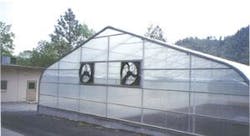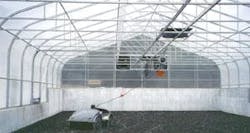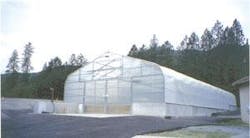Sludge Drying System Features Solar 'Greenhouse'
Plant management at the Rogue River, OR, sewage treatment facility have used a new solar sludge drying system to reduce 120,000 gallons of 2 percent sludge from its facultative sludge lagoon to 10 cubic yards of 85 percent dry sludge.
Management estimates they avoided the task of removing 80 tanker truck loads pumped directly from the lagoon, reducing the task to 1 to 1 1/2 dump truck loads of dried sludge. With the sun serving as the main source of drying energy, power requirements are nominal, while only minimal ongoing operator attention has been required.
The Thermo-System Solar Sludge Dryer was custom-designed by Parkson Corp. of Fort Lauderdale, FL, as one of its first installations of the system in North America. Parkson's licensor had previous successful installations in Germany, Italy, Belgium, Austria, and Australia for both municipal and industrial applications.
"No sludge had been removed from the lagoon for over four years, and the City of Rogue River was very concerned about the man-hours and cost required for the design removal options we had," said Ken Johnson, Director, Department of Public Works. "The city has a shortage of public works staff and a limited capital and operating budget, and we were not looking forward to the labor-intensive, repeated removal of the stored liquid sludge from the facultative storage lagoon to the city's 1500 gallon tanker truck."
The city considered a standard sludge drying bed as an alternative, but its plant did not have the spaced required. The city also considered a vacuum-type sludge drying bed, but didn't regard the technology as proven.
"The city's consulting engineer brought this new solar drying system to our attention. The city was attracted to the greenhouse-like enclosure, which seemed very suitable for our rainy climate here in western Oregon," Johnson said.
Startup began in mid-April with the new solar system. The first cycle of sludge drying took six weeks. Plant staff expect to get the cycle time down to three weeks in the summer, and five or six weeks in the winter. The city only needs three cycles a year for current operations to maintain an operable level in the lagoon.
The total cost for the system, including the Parkson-supplied equipment and additional engineering and construction for its unique situation, was less than $300,000. The system is sized to meet the sludge drying needs for the city for the next 20 years.
The City of Rogue River's wastewater treatment plant is a 1.2 mgd sequencing batch reactor (SBR) type built in 1997. It replaced a 0.3 mgd packaged activated sludge treatment plant that dated back to 1972. Current plant flow characteristics are made up of about 75 percent residential, 20 percent commercial, and 5 percent industrial.
The former smaller plant had disposed of sludge via tanker truck to farmers' fields until it was ruled out of compliance in the early 1990s, when total flow input exceeded its rating. For the new, larger plant, an 8 foot deep, 1.4 million gallon lagoon was built to store the sludge, with 3 feet of water recommended above the sludge layer. When the sludge layer reached 4 feet below the surface, the need to find a cost-effective disposal solution became urgent.
Before entering the solar dryer, the 2 percent sludge is pumped from the lagoon into a 17,500 gallon holding tank, where mixing takes place in order to establish uniform concentration. It is pumped out of the holding tank at 50 gallons per minute. A polymer is added to thicken the sludge. The treated sludge then passes through a rotary drum thickener, also provided by Parkson, where it is further thickened to 5-6 percent. Supernatant is returned to the lagoon.
The dryer features a 40 foot by 90 foot solar drying bed housed in a climate-controlled greenhouse-like structure wrapped in a translucent polyethylene material. A microprocessor controls moisture content of the air and also operates a tilling device for the sludge. The system's design calls for a sludge bed layer of 11-12 inches, but city staff filled the bed to a depth of 15 inches and still got good results for the first cycle.
Construction and installation of the system was accomplished with the assistance of five city public works employees, none of whom required special training, which helped reduce the installation cost. Nominal power requirements are needed to operate the tiller and the ventilation fans, with the sun serving as the main source of drying energy. Only minimal ongoing operator attention has been required.
In the initial sludge cycle, 120,000 gallons of approximately 2 percent sludge was pumped from the lagoon, reduced to 35,000 gallons of 5-6 percent sludge before entering the dryer, and reduced there to about 10 cubic yards of 85 percent dry sludge.
The city has constructed a 3 foot high baffle wall in the back 15 percent of the rectangular solar bed to store the dried sludge.
"A tractor is used to push the sludge to the back of the dryer," said Rick Cushman, the plant's Maintenance Technician II. "We think we can store 5-7 cycles of dried sludge behind the baffle wall, while we wait to build a storage site sometime in the next 3-4 years. We're hopeful the material will qualify as Class A, for use in gardens, soil amendment applications, and other uses."
The Thermo-System Solar Dryer consists of one or more translucent chambers, a mobile electric tilling "mole" for each chamber, sensors to monitor atmospheric drying conditions, air louvers and ventilation fans.
A microprocessor controls the drying environment by evaluating climatic variables and activating ventilation louvers and fans as needed to bring drier external air into the chamber.
The microprocessor also controls the mole, which operates throughout the chamber, controlled electrically from a tether. The mole tills the sludge bed, bringing the moist sludge to the drying surface. As the sludge dries, the mole granulizes it into a uniform, consistent, pelletized end product.
The solar sludge drying systems can be erected on a variety of flat or inclined surfaces in a range of climates, and can be adapted to retrofit existing drying beds.
Parkson says a consistent end product is always produced within a specific time frame, with changing weather conditions having little effect on results. The dryer is said to be capable of successfully treating a wide range of municipal and industrial sludges, with the system set to produce dried solids from 50 to 90 percent.



